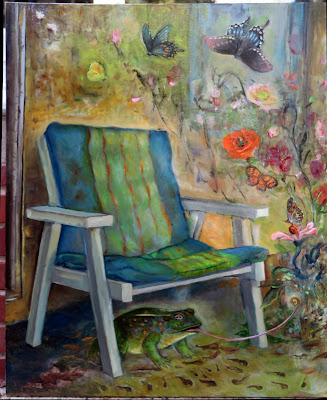In the summertime, my art work slows down. This is in part due to hotter weather and the need for more attendance to my gardens. People seem to be more outdoors than inside looking at art, leading to a more leisurely paced commercial life for me. And lastly, as a former educator married to an educator, my circadian rhythms are permanently set to a school year.
The seeking out of inspiration in numerous museum and gallery exhibitions, however, along with opportunities to exchange ideas with colleagues and generally catch up with fellow artists becomes more lively in the summer months. In this last regard, I was finally able to devote some time to studying the last figurative artist in a series I started nearly a year ago.
Gallery Neema, in Charleston is now hosting an exhibition of the drawings and paintings of Tyrone Geter. Many of these are new works so this was an exceptional treat.
Entering the gallery, I saw monumental mixed media drawings. These included works such as "Trouble and Pain" and "Freedom." Too large and heavy to be hung on the walls, a number of these giants were instead propped up against it. This had the benefit of bringing the subject closer to an intimate eye level, for a greater appreciation of the seamlessness of charcoals blending with black fabrics.
Many of Tyrone Geter’s recent figurative drawings feature exuberant - hair that seems to take on a life of its own as it rises from the body, transforming itself in to fantastic botanical forms. This exhibition did not disappoint in this theme. Yet the hair of the woman pictured in "Blown Away" took on a more aggressive presence, seemingly slicing through its paper surroundings. Ruminating about the unsettling disappearances of black women while creating this piece, the artist’s lament becames palpable in the wrenching tears of paper - like the shedding of tears in tearing.

Other topical pieces in this exhibition included "Six Weeks," a visual representation of the recent draconian anti-abortion legislation sweeping through the south, in particular in states like Alabama. The embryos in this piece - proto-human life forms now granted more civil rights than fully formed living teen age and adult women -were symbolized by a glass full of multicolored dried beans with a pastry brush stuck upright in the middle (I did a little research here and found that a human embryo at six weeks is indeed about as tiny as a bean so this is quite clever). Hovering above the dried bean offering was an oil portrait of a half hidden child, obscured by vegetation, her own personhood neglected. The presence of an ivory carving beneath her portrait, brought a modicum of hope to an otherwise somber piece.

Throughout the exhibition the artist flexed his artistic technical prowess in tackling a richness of painting, drawing and mixed media techniques, like a linguistic translating ideas into various languages. I particularly enjoyed the delicate portraits painted entirely with a palette knife, and the surprising little details embellishing the surface of charcoal drawings, like the ivory colored cowrie shells affixed to a portrait.
The complexity of this well considered exhibition and its rich variety was a worthwhile experience, and elucidated unequivocally why the artist, Tyrone Geter has recently received so much acclaim both regionally, as a Verner Award recipient, and nationally as a Yaddo Fellow.
The exhibition is up through June 30 of this month.
Next Blog: A Conversation with Tyrone Geter
Links:
https://www.tyronegeter.com/
http://www.neemagallery.com/






